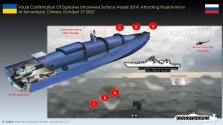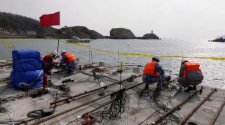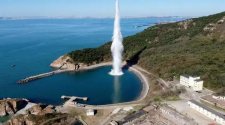I got 200 bottle caps and a case of nuka cola that after such an exchange, the USG is gonna do the diplomatic equivalent of “DUDE, IT WAS JUST A PRANK!!!”In case the Pentagon and the White House deploy their nuclear weapons, even tactical ones, regardless of against the PLA amphibious forces, or the landing beaches on Taiwan, or both - China would regard that as an unprovoked, direct nuclear attack on Chinese soil and Chinese civilians by the United States.
China would respond with full strategic nuclear retaliation. I believe that American cities being flattened and irradiated would be the only probable follow-up to that nuclear attack.
You are using an out of date browser. It may not display this or other websites correctly.
You should upgrade or use an alternative browser.
You should upgrade or use an alternative browser.
Lessons for China to learn from Ukraine conflict for Taiwan scenario
- Thread starter tphuang
- Start date
- Status
- Not open for further replies.
Ah I know. "My good sirs, this little tussle was but some playful mischief."I got 200 bottle caps and a case of nuka cola that after such an exchange, the USG is gonna do the diplomatic equivalent of “DUDE, IT WAS JUST A PRANK!!!”
I believe most of you guys have already know about the attacks on Russian Black Sea Fleet warships by the Ukrainian USVs just yesterday - the most important target being possibly the Russian frigate Admiral Makarov.

Although the exact details of damage done to the Black Sea Fleet is still hazy as of current, the methods of how this attack has been conducted reminds me of two particular raids from WW2, i.e. Douda Bay and Alexandria (both in 1941), where the Royal Italian Navy successfully employed motor assault boats and manned torpedoes respectively against Royal Navy warships in shallow waters.
I believe that this event should provide very important takeaways for China, in terms of how the PLA should employ such weaponry and platform against enemy warships and naval installations, alongside corresponding countermeasures against similar weaponry that could potentially be deployed by the enemy side.
There is one particular news just about a year ago where Chinese scientists successfully conducted simulation tests regarding attacks against seaport and naval base by detonating explosives inside a scale model port/naval base.


If China is equipped with the capability to cripple enemy naval power as soon as possible at the first signs of war even before they could have the chance to move out and fight the PLA, then it would be an absolute plus bonus for China's ultimate war effort. Furthermore, more munitions in the PLAN, PLAAF and PLARF arsenal that are initially allocated for certain land/sea-based targets could then be diverted to other targets, thus granting the PLA wider variety and volume of firepower against the enemy forces.
Therefore, suicide USVs with dual surface-submersible capabilties like the ones employed by Ukraine would do the trick well, as their depth can be adjusted according to the depth of the submerged portions of the targetted enemy warship (i.e. draft), so that warships with very shallow drafts, e.g. corvettes and fast attack crafts can be attacked as well. Unlike normal torpedoes, however, these suicide USVs should be capable of loitering, and travel for longer distances than torpedoes presently available in the PLAN arsenal.
I believe these suicide USVs could serve as China's underwater version of the missile umbrella that currently extends out into the Pacific with all the variety of anti-ship and land-attack missiles in the PLA arsenal. But of course, for targets at longer ranges, larger suicide USVs, or even the ULR nuclear-powered torpedo previously mentioned would be required instead.
For defense against enemy usage of suicide USVs against PLAN warships, naval bases and shipping ports, there should be both active and passive mthods of defense involved.
Passive defense in my opinion would be underwater-and-surface nets surrounding individual warships, naval base, key shoreline infrastructures and shipping ports.
Active defense, meanwhile, would be shore-based and sea-based defensive platforms with detection and (perferably launch-upon-detection-confirmation) interception capabilities against incoming enemy torpedoes, USVs or UUVs should be given vital consideration. Such systems can be installed on the shoreline, mounted on littorial patrol ships and boats, fitted on specifially-modified buoys, and installed on the seabed.
These defensive systems against enemy torpedoes, USVs and UUVs should thus be installed and lined up along the length of the Chinese coastline, that is, from Liaodong peninsula in the Yellow Sea all the way to the Nansha islands in the South China Sea.

Although the exact details of damage done to the Black Sea Fleet is still hazy as of current, the methods of how this attack has been conducted reminds me of two particular raids from WW2, i.e. Douda Bay and Alexandria (both in 1941), where the Royal Italian Navy successfully employed motor assault boats and manned torpedoes respectively against Royal Navy warships in shallow waters.
I believe that this event should provide very important takeaways for China, in terms of how the PLA should employ such weaponry and platform against enemy warships and naval installations, alongside corresponding countermeasures against similar weaponry that could potentially be deployed by the enemy side.
There is one particular news just about a year ago where Chinese scientists successfully conducted simulation tests regarding attacks against seaport and naval base by detonating explosives inside a scale model port/naval base.


If China is equipped with the capability to cripple enemy naval power as soon as possible at the first signs of war even before they could have the chance to move out and fight the PLA, then it would be an absolute plus bonus for China's ultimate war effort. Furthermore, more munitions in the PLAN, PLAAF and PLARF arsenal that are initially allocated for certain land/sea-based targets could then be diverted to other targets, thus granting the PLA wider variety and volume of firepower against the enemy forces.
Therefore, suicide USVs with dual surface-submersible capabilties like the ones employed by Ukraine would do the trick well, as their depth can be adjusted according to the depth of the submerged portions of the targetted enemy warship (i.e. draft), so that warships with very shallow drafts, e.g. corvettes and fast attack crafts can be attacked as well. Unlike normal torpedoes, however, these suicide USVs should be capable of loitering, and travel for longer distances than torpedoes presently available in the PLAN arsenal.
I believe these suicide USVs could serve as China's underwater version of the missile umbrella that currently extends out into the Pacific with all the variety of anti-ship and land-attack missiles in the PLA arsenal. But of course, for targets at longer ranges, larger suicide USVs, or even the ULR nuclear-powered torpedo previously mentioned would be required instead.
For defense against enemy usage of suicide USVs against PLAN warships, naval bases and shipping ports, there should be both active and passive mthods of defense involved.
Passive defense in my opinion would be underwater-and-surface nets surrounding individual warships, naval base, key shoreline infrastructures and shipping ports.
Active defense, meanwhile, would be shore-based and sea-based defensive platforms with detection and (perferably launch-upon-detection-confirmation) interception capabilities against incoming enemy torpedoes, USVs or UUVs should be given vital consideration. Such systems can be installed on the shoreline, mounted on littorial patrol ships and boats, fitted on specifially-modified buoys, and installed on the seabed.
These defensive systems against enemy torpedoes, USVs and UUVs should thus be installed and lined up along the length of the Chinese coastline, that is, from Liaodong peninsula in the Yellow Sea all the way to the Nansha islands in the South China Sea.
Last edited:
solarz
Brigadier
This is one issue no one has considered — use of tactical nukes against landing force.
Sounds very much like MacArthur's idea of nuking the China-Korea border.
Presumably the project to develop a missile with supercavitating terminal phase would enhance these capabilities to a truly generational advantage level.I believe most of you guys have already know about the attacks on Russian Black Sea Fleet warships by the Ukrainian USVs just yesterday - the most important target being possibly the Russian frigate Admiral Makarov.
View attachment 100494
Although the exact details of damage done to the Black Sea Fleet is still hazy as of current, the methods of how this attack has been conducted reminds me of two particular raids from WW2, i.e. Douda Bay and Alexandria (both in 1941), where the Royal Italian Navy successfully employed motor assault boats and manned torpedoes respectively against Royal Navy warships in shallow waters.
I believe that this event should provide very important takeaways for China, in terms of how the PLA should employ such weaponry and platform against enemy warships and naval installations, alongside corresponding countermeasures against similar weaponry that could potentially be deployed by the enemy side.
There is one particular news just about a year ago where Chinese scientists successfully conducted simulation tests regarding attacks against seaport and naval base by detonating explosives inside a scale model port/naval base.
View attachment 100503
View attachment 100502
If China is equipped with the capability to cripple enemy naval power as soon as possible at the first signs of war even before they could have the chance to move out and fight the PLA, then it would be an absolute plus bonus for China's ultimate war effort. Furthermore, more munitions in the PLAN, PLAAF and PLARF arsenal that are initially allocated for certain land/sea-based targets could then be diverted to other targets, thus granting the PLA wider variety and volume of firepower against the enemy forces.
Therefore, suicide USVs with dual surface-submersible capabilties like the ones employed by Ukraine would do the trick well, as their depth can be adjusted according to the depth of the submerged portions of the targetted enemy warship (i.e. draft), so that warships with very shallow drafts, e.g. corvettes and fast attack crafts can be attacked as well. Unlike normal torpedoes, however, these suicide USVs should be capable of loitering, and travel for longer distances than torpedoes presently available in the PLAN arsenal.
I believe these suicide USVs could serve as China's underwater version of the missile umbrella that currently extends out into the Pacific with all the variety of anti-ship and land-attack missiles in the PLA arsenal. But of course, for targets at longer ranges, larger suicide USVs, or even the ULR nuclear-powered torpedo previously mentioned would be required instead.
For defense against enemy usage of suicide USVs against PLAN warships, naval bases and shipping ports, there should be both active and passive mthods of defense involved.
Passive defense in my opinion would be underwater-and-surface nets surrounding individual warships, naval base, key shoreline infrastructures and shipping ports.
Active defense, meanwhile, would be shore-based and sea-based defensive platforms with detection and (perferably launch-upon-detection-confirmation) interception capabilities against incoming enemy torpedoes, USVs or UUVs should be given vital consideration. Such systems can be installed on the shoreline, mounted on littorial patrol ships and boats, fitted on specifially-modified buoys, and installed on the seabed.
These defensive systems against enemy torpedoes, USVs and UUVs should thus be installed and lined up along the length of the Chinese coastline, that is, from Liaodong peninsula in the Yellow Sea all the way to the Nansha islands in the South China Sea.
It would not be difficult to automate missile boats carrying several such underwater drones once they have been developed. But so far this seems to be just a prototype without name.
The power balance of China is far more favorable than that of Ukraine, but like the proverb of fighting a wolf with the style you would fight a tiger, it is better to overreact than underreact. In anticipation of a foreign invasion, China must not just develop weapons at a normal pace but prepare society to enter "desparate battle" where everything, even something like unmanned boats or trucks filled with explosives, if they can be used to achieve victory, must be used. This part of Ukrainian mentality is highly laudable and should be taken as an example for China's own resistence.
Kazakh?Lol Wanwan's are so delusional.
Kazakhstan President be like:

"U wot mate?"
I'm surprised that the Wanwanese game developer didn't bother to include ethnic Chinese Koreans and ethnic Chinese Russians. Maybe because including Koreans and Russians isn't politically correct in Taiwan LMAO.
But hey, since the Wanwanese already provided an example, I think now is the time for China to publish a "United Front" game, where people from as many of the 56 ethnic groups in China as possible are united in the modern era of the People's War against separatist forces on Taiwan + malignant foreign forces aiming to destroy the civilization state of China - under the flags and banners of the PRC, CPC and PLA.
Fight against everyone especially China but not Japan??Lol Wanwan's are so delusional.
Funny as it is, I don't believe this one is relevant to the discussion.Lol Wanwan's are so delusional.
Well I want to bring attention to how retarded wan wans are and how we can easily take advantage of that.Funny as it is, I don't believe this one is relevant to the discussion.
- Status
- Not open for further replies.
